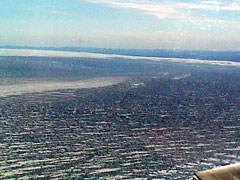
Greenland Internship
StudentNow | Features | Shopping | Travel | Jobs | Research | Fun | Life | Sports | Colleges
| Travel Center |
| Travelocity Links |
| Discount Travel |
| Travel Bookstore |
| General Services |
| Guides & News |
| Maps |
| Currency Converter |
| Destinations: |
| Amsterdam |
| Travel Suggestions |
| Travel Magazines |
| StudentNow |
 |
|
Continued: Student
Journalist Experience in Greenland
When it was too cloudy to fly, we had the day off. The town we were in, Kangerlussuaq, is the home of Greenland's major international airport, and that's about it. There was also a restaurant, a grocery store and a paved road that ran down to the port and past the hotel. One day, several scientists, a pilot and I followed a dirt road to the edge of the nearest glacier and hiked along the face. Sharp ridges of blue ice clashed with the blue of the sky, and deep booms from the volatile glacier alerted us to keep our distance. We sat down to watch a spot that seemed particularly likely to break apart soon, and several small falls confirmed this. So we sat, staring intently at the behemoth before us. A stream of melting ice roared along the edge of the sheet to the fjord and eventually into the sea. After looking down at the ice sheet from 1,600 meters, seeing it loom above me helped put the incomprehensible size into perspective, although I still have a hard time imagining how much ice actually fits into a sheet 3 kilometers thick and covering eighty percent of Greenland. The crack I had been staring at continued to widen almost imperceptibly. Small pieces of ice broke from the face and dropped into the water, and then without warning, the entire face of the glacier split off and thundered to the ground. The huge chunk broke apart and the impact sent a wave of water and projectiles hurtling into the. The reverberations echoed across the rocks. That huge piece, which could have smashed a large house, was simply an immeasurably small fraction of the ice sheet it broke from. The weight of thousands of miles of ice was pushing that glacier toward the ocean. If all that ice melted, it would put Florida under water. Scientists are only beginning to understand the polar ice sheets and how they are changing. The KU scientists will work the rest of the summer analyzing the data they gathered, then they will improve their radars and come back next year to continue the unending process of scientific inquiry. |
||
StudentNow | Features | Shopping | Travel | Jobs | Research | Fun | Life | Sports | Colleges
©1996-2010 COPYRIGHT StudentNow - click for information other notices.
 By
Eve Lamborn
By
Eve Lamborn